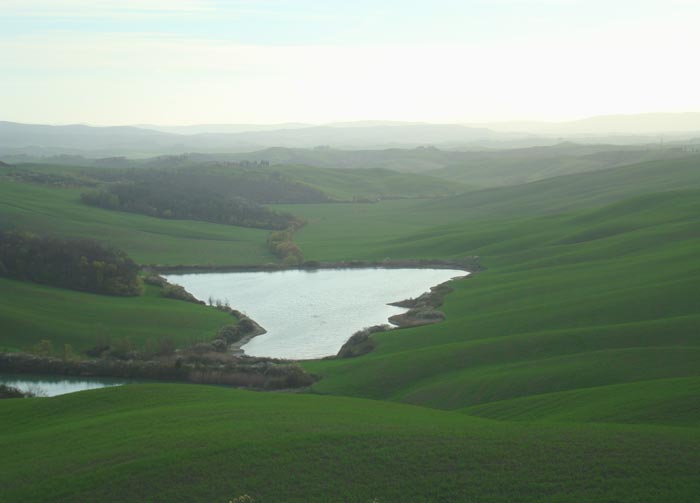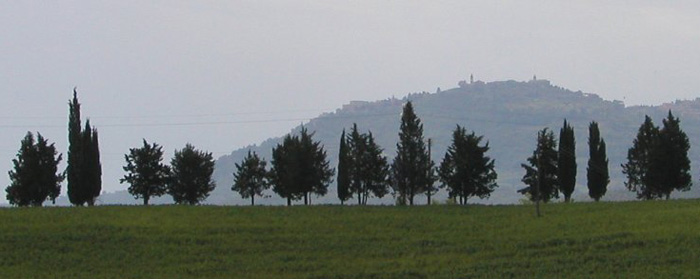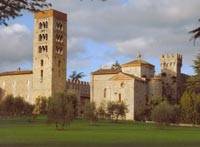| |
|
The territory around Siena is actually the best example of Tuscan regional identity, rich in natural resources and productivity, beginning with the famous "Chianti-shire" which extends north from Siena with its precious vineyards. Terraced hills and valleys rich in rivers, castles, churches and wonderful buildings dot the countryside.
Castles and villages like Castelnuovo Berardenga, Castellina, Gaiole and Radda in Chianti overlook the wonderful countryside, where we can still admire extraordinary 18th century gardens in Arceno, Pontignano, Villa la Pagliaia, Catignano, Geggiano and Sestano in the town Castelnuovo Berardenga.
The Val d'Elsa valley is crossed by the historic Via Francigena pilgrims' route, with many smaller roads which lead to the sea. This area has been a strategic meeting point for merchants and pilgrims going to Rome since the middle ages.
In the Val d'Elsa area is San Gimignano, with its many towers, and Monteriggioni, which is famous for its medieval city walls. The famous architect Arnolfo di Cambio was born in Colle val d'Elsa, also known as the "crystal town".
The Merse valley is rich in woods, waterways, nature routes and small medieval churches and castles in Chiusino, Monticano, Murlo and Sovicille.
The northern side of river Merse belongs to the nature reserve of Alta Merse, while the river Farma flows along the valley to meet the Merse and Ombrone, reaching the famous thermal baths by Petriolo, already famous in the days of the Pope Pius XII.
During the middle ages, this area was often chosen by religious men and hermits because of its peaceful quietness and a lot of beautiful abbeys still bear witness to this tradition, like the Cistercian abbey of San Galgano by the town of Chiusdino.
South of Siena we find the world famous district called "Crete senesi", an unusual natural landscape created by prehistoric erosions on sand and clay. This special "lunar landscape" is the perfect backdrop for small medieval villages like Asciano, Buonconvento, Monteroni d'Arbia, Rapolano Terme and San Giovanni d'Asso.
The neighbouring valley, Val d'Orcia, offers a gentle landscape rich in hills and cypresses. The river Orcia flows through the valley and woods, while many interesting old towns are situated along the medieval route of the road Via Cassia. For example Radicofani, Castiglione and San Quirico d'Orcia, and then – towards Val di Chiana – Pienza and Montepulciano.
This is the home of the famous red wine, Brunello di Montalcino. It is also famous for its spas, thanks to the ancient thermal baths at Bagno Vignoni and Bagni San Filippo.
Great wines in Montepulciano, salami in Sinalunga and the healing waters by Chianciano Terme, Montepulciano and San Casciano dei Bagni: the whole valley Val di Chiana is a cradle for wellbeing and taste. History has always played an important role here: interesting prehistoric finds near Mount Cetona bear witness to a millenarian life in the valley.
The cave called "Lattaia" was the site of an ancient water worship. Local water was actually believed to help mothers during the lactation. Inside the so called St. Francis' cave there were old fireplaces and burned remains of legumes and cereals.
Mount Amiata (1738 Mt.) overlooks the valley Val d'Orcia (Montepulciano, Pienza e Montalcino) in the southern part of the province, with the hills by Chianciano and Chiusi and the great plain of Maremma. The woods in this area was inhabited as far back as Etruscan times and the region was crossed by the medieval pilgrims' road Via Francigena.
The region today is a well known tourist destination and a famous ski resort, thanks to its numerous slopes and tracks for cross country skiing. The ski lift links the mountain to the valley going through wonderful chestnut trees and beeches.
The small neighbouring town Piancastagnaio gets its name from the several chestnut groves in this area.
|
|
|
|
| |
|
The Medici family inaugurated the tradition with the villa in Poggio a Caiano, the first of 18 country residences all over Tuscany The villas had a double function: not only were they places where the members of the family could relax, they were also places where to receive the most prestigious guests.
The buildings were therefore decorated with important works of art and had big parks in which fountains, plays of water and statues aimed at impressing the guests and celebrating the owners` power.
Many of these villas are now open to the public and represent a unique occasion for experiencing how the most important Tuscan aristocratic families lived in the past centuries.
|
The garden of Vicobello
|
The garden of Vicobello near Sienna was one of the first smaller gardens of the Rennaissance to be created. This delightful and secluded spot was where Cardinal Flavio Chigi, nephew of Pope Alexander VII, would retire with his guests to rest and devote himself to his favourite pastime of hunting in the woods of evergree oak (ilex trees) which surrounded his property. The Chigi family commissioned the architect Baldassare Peruzzi to design the house and gardens between 1528-31 on one of their farm estates. Though on a much smaller scale than Peruzzi's Roman villas, the villa and gardens of Vicobello testify to Peruzzi's reputation for purity and unity of design, so understated sometimes that one could not be sure it was by his hand. Harold Acton dubbed him an `architect's architect' — and Sir Geoffrey Jellicoe, an influential writer on gardens, rated Peruzzi second only to Vignola in 'delicacy and refinement'. What remains today of Peruzzi's garden is the layout. Vicobello sits on the ridge of a hill with a view over Siena, but it was conceived to be seen from Siena as an ensemble, the villa and garden representing the distinctive Chigi coat of arms: a pyramid — which could either be of bullions of gold symbolizing their financial power or represent the hills of Siena — topped by a star. A series of terraced walled 'secret gardens' rise in pyramidal fashion to the top, crowned by the villa. The Chigi arms are repeated throughout the garden, fashioned in box, in stone, as punctuation points, or in escutcheons. Peruzzi was also known for his understated use of old materials —brick and uncut stone — and these are evident in the construction of the walls, which 'give opportunity for many charming architectural effects'
With his 1905 plan shown above, Inigo Triggs supplied a description of the garden of Vicobello as a 'series of eleven terraces, planted with long rows of square-cut ilexes descending to a meadow or ragnaia at the foot of the hill where formerly the young gallants resorted for the snaring of birds'. He went on to list a chapel, a coachhouse and an orange garden, bordered on one side by a long, low limonaia for overwintering tender potted fruit trees and on the other sides by thick-set hedges of cypresses and laurel, and its orange trees set within box-edged flowerbeds.
The villa is flanked on one side by the natural ilex woodland (Bosco) which Edith Wharton described as 'the indispensable adjunct of the Italian country house'. This remains today just as she saw it. On the other side of the villa is the upper walled garden where the limonaia overwinters the heavy pots of lemons on display in the box parterre from May to November. These are the most glorious feature of the garden of Vicobello today and can best be admired from its summerhouse – which Wharton described as a 'charming garden-house at the end of the path, in the form of an open archway faced with Doric pilasters, before a semicircular recess with a marble seat'. Fruit trees make an orchard in the walled garden directly below it, and a large cedar of Lebanon dominates the terrace below that. All the planting in the garden has been altered several times, the present scheme replacing what Wharton reported nearly a century ago as 'densely shaded' terraces 'planted with straight rows of the square-topped ilexes so characteristic of the Sienese gardens' which descended 'to a level stretch of sward (perhaps an old bowling green)' and ending with the ragnaia.
Gardens in Tuscany | Villa Vicobello
|
|
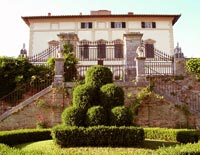 Villa Chigi a Vicobello Villa Chigi a Vicobello |
Villa Cetinale - Architect Carlo Fontana, disciple of Gian Lorenzo Bernini, built the impressive Villa Cetinale between 1676 and 1678 by order of Cardinal Flavio Chigi, who wanted to celebrate the ascension of Fabio Chigi to the papal throne with the name of Alexander VII. The magnificent villa, which the Chigi family always used only as a private residence and not as a place where to entertain guests, is a great example of baroque architecture. Architect Fontana may have designed also the garden spreading out behind the building, which was once decorated with plenty of plays of water, fountains and false ruins. In 1687 Giuseppe Mazzuoli sculptured the enormous statue representing Hercules situated in the lower part of the garden. The so-called "parco della Tebaide" (Thebaid park) was realised between 1698 and 1705. The word Thebaid was used to indicated the Egyptian desert, where the 3rd-century hermits led an ascetic existence. It is rumoured that Flavio Chigi ordered this part of the wood surrounding Villa Cetinale be decorated ... Villa Cetinale.
Gardens in Tuscany | Villa Cetinale |
|
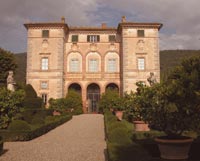 |
|
| |
| |
|
|
Eremo di Lecceto
The Augustinian hermitages and the Great Duke's tunnel
The Abbey of Lecceto - on a walk near Siena
Ten minutes far from Siena, inside the thick Lake's wood, a plunge into the past life in search of two Augustinian hermitages (monasteries): we'll visit Eremo di Lecceto (Lecceto's hermitage), a place of great quietness and meditation, the hermits' grottoes, San Leonardo's hermitage, with the wonderful frescoes painted by Lippo Vanni, and, great conclusion, we'll walk through the Great Duke's tunnel, an incredibile subway digged more than two centuries ago to reclaim the next marshlands of Pian del Lago. |
|
 |
Certosa di Pontignano
|
|
|
Castello di Belcaro Outside of Porta San Marco is the 12th century Castle of Belcaro, a building that has undergone a number of alterations over the centuries, first by Baldassarre Peruzzi and then by Partini.
The castle is surrounded by a large park with shade trees.
In 1525 the banker Crescenzo Turamini commissioned Baldassarre Peruzzi to draw up plans for a villa that was to stand over the ruins of the previously existing castle. Peruzzi was almost certainly also responsible for some of the fresco decorations within. When the castle-villa was captured by Cosimo de’ Medici in 1554 it was restored to its original function as a fortress. In the second half of the 19th century Giuseppe Partini was commissioned to carry out further restorations, this time on the entrance portico and the perimeter walls.
Currently there are three open spaces composed of the gardens and two courtyards. The main entrance into the complex is through a large gate that leads into the first courtyard, triangular in shape. A second lower arch then leads into the internal courtyard, with the villa on the left and the servants quarters on the right. The villa itself is rectangular in shape, on three floors. Within the garden is the chapel and a frescoed loggia. The Pieve di San Giovanni Battista, or Pieve di Ponte allo Spino, is one of the most important monument of Sovicille and was built from XII and XIII century by monks of Torri. The structure of the church is with nave and two aisles divided by columns with capitals and terminal apses. Inside it conserves a fourtheenth-century Madonna of Senese's school.
|
|
|
Castello delle Quattro Torri North of Siena, in the locality of Santa Regina, the medieval castle of the "Quattro Torri" can be visited only on the outside. IThis castle dates from the 14th - 15th century. The original structure with the four tall towers, which gave the name to the fortress, is basically unchanged.
Continuing towards Gaiole in Chianti, one can reach the medieval Castle of Brolio with the Palazzo of the baron and the family Chapel,
|
|
|
| Castelnuovo Berardenga is located in the extreme south of the Chianti area, in the Ombrone valley, near Sienna.
After Montaperti the Sienese Republic decided to supply its new outpost with new fortifications (hence the name, which means New Castle) but they were never completed. Evidently this stretch of Chianti was destined for peace and cultivation of the spirit rather than for military defence. A visit to Castelnuovo Berardenga cannot exclude the Villa Chigi Saracini with its superb architectural elegance embellished by a formal garden. It is enriched above all by a 19th century park of considerable botanical importance.
The Villa Chigi Saracini was designed in the early 19 C by its owner, Galgano Saracini, and stands at the entrance to the Castelnuovo Berardenga. Its construction led to a radical alteration of the urban layout of the town, with the demolition of the enceinte around the castle and its replacement by a retaining wall.
The building, rectangular in plan, spreads over three floors, the lower portion being rusticated and the upper floors finished in plaster. The romantic-style park was created by Agostino Fantastici in 1834, as were the architectural features: the triple-arch bridge (designed for carriages to pass over) linking the villa to the San Quirico hill.
The way the park now looks like is due to Count Guido Saracini, great music lover and founder of Chigiana Music Accademy.
Comune | www.comune.castelnuovo-berardenga.si.it
|
|
|
Badia Monastero | Monastero d`Ombrone
|
|
|
The village of Monastero d`Ombrone, an ancient medieval stronghold of which we have information starting already from the 11th century, belongs to the municipality of Castelnuovo Berardenga. The place name Monasterio refers to the nearby church of San Salvatore della Berardenga.
Badia Monastero was built to remind the 15th February 867 deed, when Count Winigis and his wife Richilda founded the women monastery of Santi Salvatore e Alessandro di Fontebuona a Campi. Later named San Salvatore della Berardenga. The monastery probably declined and was re-founded in 1003; this time it was given to a Benedictine male community. For the first time in 1028, it is mentioned as part of Camaldoli congregation. In XIV century the Abbey started to decline. Since early 1800 it is not a monastery anymore. Monastery and connected outhouses are currently used as villa and farmhouse. At the North-Western corner of the complex there is a cylindrical tower, re-built over the original one in Neo-gothic style. On the villa Eastern side there is a wooden bridge that leads to the garden. On the villa left side stands a Romanic imposing bell tower in Lombard style with a squared plan. At the opposite side there is the S. Salvatore Church, which is mentioned since monastery foundation.
Matteo di Giovanni
Saint Augustine and Saint Michael the Archangel
tempera on panel 196x55 cm (frames included) (1474)
Asciano - PALAZZO CORBOLI MUSEO D'ARTE SACRA
Two side panels of a lost polyptych whose central panel, the Annunciation, is today at the National Gallery in London. Formerly from the Augustinian church of Asciano it was transferred to the church of Santa Eugenia in Monastero, nearby Siena. The paintings represent Matteo di Giovanni’s stylistic period in which he is attracted by the Renaissance’s new ideas of an “eccentric and bizarre” taste. (C.Alessi)
|
|
|
The Convent and Basilica dell'Osservanza was built by order of Saint Bernardino of Siena and was later restructured and expanded, possibly by the architect Francesco di Giorgio Martini. After extensive damage by allied bombardment in World War II, it was rebuilt in the last century in accordance with the original plans.
The façade is preceded by a porch (porticato) with a steep roof. The upper part is bordered by two pilasters on the sides and a large fronton (frontone) above.
In the interior are of interest:
- 4th chapel: triptych by Sassetta or by the Master of the Osservanza, on the arch: terrecotte by Andrea della Robbia and on the right wall a poliptych by Andrea di Bartolo.
- 2nd chapel: terracotta by Andrea della Robbia representing the coronation of the Virgin.
Attached to the church is the Museum.
Basilica dell'Osservanza, Strada dell'Osservanza, 753100 - SIENA | Telefono del Convento: 0577-332444 | www.basilicaosservanza.it
|
|
|
The ancient Castel Pietraio is now the home of the Fattoria di Castel Pietraio. This winery is part of the "District of the Montagnola Senese", located at the foot of Monte Maggio.
The most ancient part of Castel Pietraio is the 10 C tower with its Guelph battlement. The construction, dating from 1300 to 1500, created the quadrangular ground plan with its internal cloister. The construction of the church dedicated to the Saints Peter and Paul is of the same period.
|
|
|
|
|
| |
 |
Most of the itineraries around Siena are covered by the Carta Turistica (Turistic Maps) and by the Sentieri della Montagnola Senese 1:25000 (The Sienese Montagnola Paths) Club Alpino Italiano (CAI: Italian Alpine Club) Sezione di Siena (Multigraphic Edizioni, Firenze).
Walking in Tuscany | Itineraries in the surrounding hills of Sovicille | Sovicille, Villa di Cetinale, Castle of Celsa, Cetina, Pieve di Pernina, Pieve di San Giusto a Balli, Abazia di Santa Mustiola, Stigliano and the Ponte della Pia
Anello Sovicille | Sovicille – San Giusto – Villa Cetinale – Il romitorio di Cetinale - Pieve di Pernina – Ancaiano – Villa Celsa - 16 km (Italian)
|

Southern Tuscany is an undiscovered jewel. The territory known as the Crete Senesi contains all of those things which we have come to associate with Tuscany: a landscape of gently undulating hills, lined with cypress trees and covered by a patchwork of fields, olive groves and vineyards.
Just south of Siena is the intriguing and distinctive semi-desert landscape of the Crete, which break up the enchanting green landscape of this part of Tuscany. The Crete are geographical features of clay, harsh and wild, difficult to cultivate by anyone who is not an expert and who doesn't respect the laws of nature.
This area was made famous by the Battle of Montaperti between the Florentines and the Sienese in 1260, which took place here. It is also well-worth making a visit to the atmospheric complex of the Abbazia di Monte Oliveto Maggiore, which was founded in 1313 by Giovanni Tolomei; surrounded by centuries-old cypresses, it dominates the landscape of the Crete. Besides the many works of art there, the abbey also has a library of forty thousand antique books, testimony to the cultural and artistic importance of the abbey between the 15th and the 16th century.
Walking in Tuscany | Southern Tuscany | Montalcino, Siena, Socicille, San Gimignano and the Val d'Elsa
|

Located on the outskirts of Castiglioncello Bandini, Podere Santa Pia is one of the best places to slow travel in southern Tuscany. This holiday house offers the quiet tranquility of a private retreat, with numerous attractions, beautiful nature reserves and unspoilt beaches within easy reach.
Explore the medieval hillside villages of Sovicille, Civitella Paganico and Monticiano on your way to Siena, watch the Ponte della Pia near the Eremo di Rosia and marvel at settlements that date back to Etruscan times, try some Vino Nobile wines in Montepulciano, or the Brunello wines in Montalcino, counted among the most prestigious of Italian wines, cities where the refined beauty of the squares and churches blends perfectly with the ancient traditions of its red wines.
Hidden secrets in Tuscany | Holiday home Podere Santa Pia
|
 |
Podere Santa Pia is situated in a hilly and unspoilt land, about one hour drive from Siena, surrounded by woods, olive groves and vineyards, and is one of the best places to slow travel in southern Tuscany
|
|
| Certosa di Pontignano | History
In the first half of the XIV century Bindo di Falcone, a gentleman from Siena who had become rich through trade with the Papal States, bought land and goods in the small town of Pontignano, and gave them as a donation to a Carthusian monk from Aquitaine, brother Amerigo, so he could establish a monastery dedicated to Saint Peter. On August 8, 1343, the Bishop granted permission to Bindo di Falcone to set up the Certosa. The plan provided for building a church, with cloisters, cells and service buildings which could “House twelve fathers, twelve lay brothers and their servants”.
The church - the first building to be built - preserves certain 14th century features, such as the thick surrounding walls and the arcades. The Certosa was built in the open country, on the border between the states of Florence and Siena; it needed to mark off its own borders and to be defended against raiding mercenaries.
In 1385 the state of Siena, acknowledging the importance of the settlement, had strong walls built around it. In the same year, Stefano Maconi, Saint Catherine’s favourite disciple, was appointed prior of Pontignano. It was probably he who obtained the relic of the ring finger of the Saint - the chapel, later painted with frescoes by Nasini, was built to host it.
The Certosa also enjoyed the protection of Gian Galeazzo Visconti due to the merits acquired by a monk from Pontignano who oversaw a large part of the building work in the Certosa of Pavia. Its walls notwithstanding, the Certosa was violated and sacked during the war between Siena and Florence. In 1449, a band of Florentines broke in, and during the famous “Congiura dei Pazzi”, the monastery was set on fire. Immediately after it was again damaged: in 1554, German and Spanish militias sacked the monastery.
During the late 15th Century, the building received considerable impulse from Renaissance elements. These are mainly visible in the cloister along the long side of the church: its square layout, with five spans per side and sail vaults held up by small columns with Ionian capitals show clear features of equilibrium and sobriety. Other minor work was done at the end of the 17th Century, when the rooms along the eastern side of the monastery were refurbished: the six Chapels built previously were united in the so called “Cappellone” or big chapel.
In 1703, the Chapel of Saint Agnes was built: its door lies a the end of the eastern arm of the big cloister.
The Carthusians who had devoted so much care to Pontignano, making it an oasis of peace, left the Certosa at the end of the 18th Century. A document dated July 16, 1785, transferred Pontignano to the monks of Camaldoli, who however were forced to leave it when the convents were suppressed under Napoleon. The parish of San Martino a Cellole was then moved to Pontignano; the buildings, except those where the parish priest lived, were purchased - together with the old monks’ dwellings and some land - by the Masotti family, who sold them in 1886 to the Cecchinis, who in their turn passed them on in 1919 to the Sergardis. In 1939, the area became the property of the Certosa di Pontignano company, one of whose shareholders was professor Mario Bracci. In the same period, the future Judge of the Constitutional Court had the villa and the small middle cloister repaired at his own expense. Throughout the war period, Pontignano was a secure place of refuge for Jews and the victims of political persecution.
In 1959, the complex was purchased by the University of Siena, who then turned it into a university residence. |
|
|
